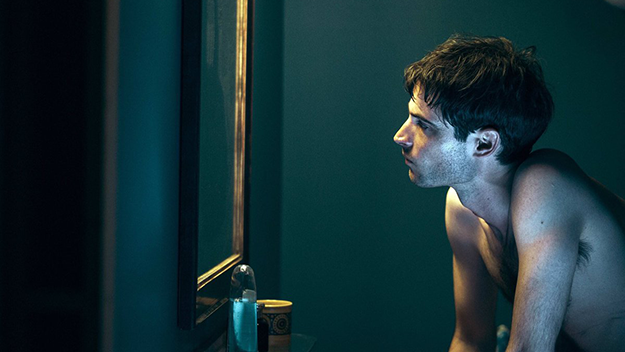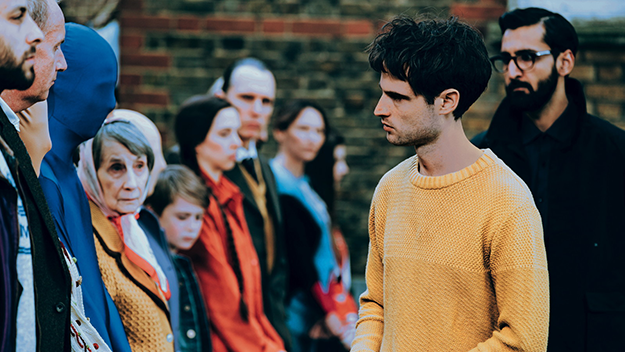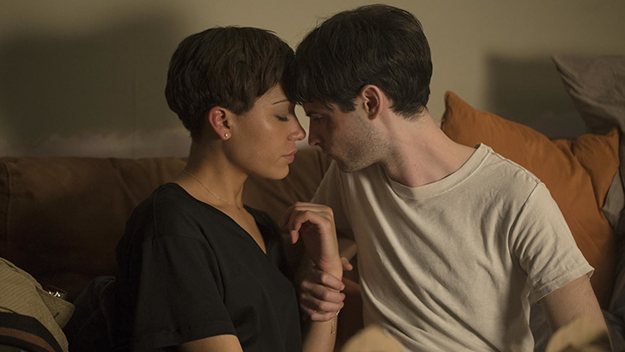ND/NF Interview: Omer Fast
A refined puzzle in which fiction and reality collide dangerously, Omer Fast’s new film elaborates on a world where—at least on our devices—there’s always an “undo” button. The theatrical feature debut of the Israeli-born U.S.-raised video artist adapts the 2005 novel by British writer Tom McCarthy. Both novel and film go by the title Remainder, a term that the German audience at the 66th Berlinale often misread as “reminder.” The recurring mistake is ironic, given that Tom, the story’s Londoner protagonist, pays excessive attention to the tiniest detail, becoming a “control-freak Robinson Crusoe of contemporaneity,” as Fast puts it. Following a mysterious accident, Tom suffers from amnesia and receives an enormous compensation. He’s stricken by sudden flashbacks that leave him with a deep sense of serenity. These impel him to fabricate and reenact events from his blurry memory, hiring actors and designing entire sets.
Like Fast’s previous works, Remainder is at once a fulfilling and ungraspable experience. In the medium-length Continuity (12, and its 2015 extended version) and 5,000 Feet Is the Best (11) he edits stories about the conflicts in the Middle East into a continuous loop that immerses us in the subject matter but flouts our expectations of linear storytelling. The influence of memory and language, the cyclical nature of individual and collective experience, the confusion between fiction and reality, and the dismantling of experience through reenactments all recur in his oeuvre. Yet his intention appears to be not a critique of contemporary society but rather an investigation of the moral and existential ambiguity of current times, whether regarding sociopolitical events or more personal ones. Fast’s films reveal an ambition for order and clarity that result in a sleek and rarefied aesthetic even when their content deals with violence and incongruity. Tom in Remainder perfectly embodies such tensions.
Since at least Spielberg’s List (03), Fast’s craft has always flirted with traditional cinema, and it is significant that he’s chosen this story as his “big” screen debut. Remainder, which screens in New Directors/New Films on March 21 and 22, had its world premiere in February at the 66th Berlinale, when I met with the director.

To what extent was Tom McCarthy involved in the film’s production?
He was involved in several ways. At the beginning he put me in touch with the company that originally optioned the rights for the book. I was interested in possibly taking on the project and it was through his agency, I believe, that I was invited to work on the book. That was months after I originally contacted him to tell him how much I liked the novel and that I wished we’d do something together. We sat together for several days during development and created this flow chart, a cryptic looking map of what Remainder is like in terms of events, characters, relationships. It was literally a big messy cloud with names, and arrows, things like this. It was helpful in wrapping my head around the book.
Was that to give you a comprehensive blueprint of the story?
At the time we didn’t know each other—we eventually became very good friends—and processing the book together helped me get a representation of the story that I could work on without having to literally flip pages. After that, he was much less involved. I guess he put some distance between himself and the project. I believe it was very clear for him that he was going to be the author of Remainder but he wasn’t going to be its scriptwriter. I think there were very positive and very negative ramifications to that. Eventually he also read a draft or two. His feedback was as a reader of the script (of course with quite a bit of insight), but at the time Film 4 and the BFI were already very much involved in the development.
“Remainder” has several meanings. Is there a particular significance you attribute to the title?
Tom had few conditions—one of them was that the movie would be called Remainder. There is a problem in Germany with the title because they keep saying “reminder” but it’s not “reminder” it’s “remainder”! And “reminder” just makes me cringe. Remainder for me has a much sexier connotation. First of all it’s about “stuff.” Tom McCarthy (and the protagonist also) is very concerned with stuff. During the whole book the protagonist is talking about stuff getting in his way but it’s also the stuff he’s using in order to have an understanding of time and space. It also means what’s left behind, so of course comes the question: what is left behind after an accident, after we’re gone? In that regard the title is really nice—it’s a somewhat cryptic title but it has a very direct set of associations with matter.
It also has a meaning in mathematics and property law.
In mathematics, it represents a surplus. He receives the compensation amount of £8.5 million. It’s a lot of money and most people would be like “Wow!” Instead, what he fixates on is the numeral after the decimal point. “Why had they added the half?” That is the spirit. He is a very compulsive, obsessive individual.
As viewers, we have to reconcile what we know with what Tom remembers. How did you visualize the experience of amnesia?
We tried to do several things. Visually one of the things was to restrict the field of vision. We opted away from very wide shots and wide lenses. We used longer lenses and closer depth of field to peel the figure away from the landscape and create this kind of narrow sense of perception, which is a little claustrophobic. When figures appear they don’t have a proper context. Visually we put the viewer into the same kind of subjective-perceptive condition of the protagonist. He doesn’t have a context. He has difficulties understanding where figures, people, and events fit. We tried to create something similar with sound. We filtered the sounds from the background. For instance, he would sit having conversation and pay attention to the air ventilation. We’d play around with modulating the sound in this way.
There’s an attempt at creating feeling of disorientation and digression—something I noticed in your previous work, too. In Spielberg’s List you played with juxtaposed images and subtitles bearing different meanings, leaving the viewer confused about what he should be following. How has your work changed, now that you have made the jump from video art into “traditional” cinema?
The language we use for Remainder is more condensed and in some degrees less contradictory or less confusing than the one I use in some of the works I do as an artist. Often, as an artist, I’m very happy to describe something or to talk about something by looking at how that thing could appear for different people. I’m interested in using different descriptions but never actually the thing itself. This multivalent, ambiguous resonance is in the film but to some degree streamlined.
Tom has visions of a huge building he eventually purchases. Before he buys it, we see the Madlyn Mansions first as a cardboard model, then in his memories, then in pictures. How does this fit into your use of repetition?
I think that the protagonist is very much involved in an activity which is analogous or parallel to how a visual artist, a theater, or movie director works. He’s trying to visualize experience and the problem is he’s unable to sort out where that experience belongs, both spatially and temporarily. For a long time we assume it’s something from his past, and it is, but later we find out that he’s actually trying to pre-visualize his present and his future. There is a cyclical structure to the story.
On the role of language, when Tom starts working with Naz (a real estate agent that becomes his assistant), he shares his memories with him almost as a confession. Considering how you employed interviews in previous works like 5,000 Feet Is the Best and The Casting (07), how did you formulate Tom’s dialogue?
A lot of the writing or the dialogue in the movie is actually lifted from the book. There’s an analog with my work because very often I need to work with people and I sit down with somebody and have a conversation because I find something about them interesting. Usually it’s their work, whether they’re adult film performers or a drone sensor operator or the extras in a Hollywood movie. In that regard I’m a portraitist. And I think of my work as portraits. With Remainder I didn’t have an interview text but I had a novel. That conversation, when he meets with Naz, is very close to what transpires in the book.
In your previous work, you explored the notion of improvisation. For instance, in The Casting, you asked actors to improvise. In Remainder, Tom has an encounter with a call girl and asks her to follow a sort of script. When she improvises, he becomes angry and violent.
Because he’s a control freak. I think there is a contradiction to what he does: in a sense he’s working like a very old–school avant-garde theater director. He’s creating a situation which blurs the line between art and life. This is the dream of the historical avant-garde: the blend of those two worlds so that we don’t have this comfortable separation where we have an institutionally sponsored art that we can experience and then we come home and life resumes. He’s unknowingly trying to combine those two things. On the other hand, though, because he’s so desperate to get the details right, he’s not creating spaces that encourage improvisation and surprise. He’s surprised by things at the end but in spite of what he’s trying to do. He’s captive to things he’s unaware of and, as much as he tries to control things, in the end they reformulate around him and surprise him.
Once he acquires the building in Brixton, Tom and his “crew” redecorate it according to his memories. He then hires actors to act out his visions. Naz imparts his instructions from a control room that looks like an editing room, asking the actors to perform, stop, and resume so that Tom can roam freely through the space.
There is this notion of providing some kind of model for performance—whether we want to call it performance inside of an art context or a more radical notion of performance that’s actually unfolding in life. And then, of course, the notion of “freeze” rather than “action” is a kind of perverse inverse to that. He creates situations, tableaus, that he then tries to freeze so that he can move through them. It’s less about the action that’s happening between the individuals and more about his ability to move around these environments.
It taps into the idea of surveillance but also our familiarity with technological operations—undo, redo, freeze frame—which aren’t natural for us.
Another possible key to understanding that is that he’s using this digital, post-modern logic and he applies it to these more traditional situations that involve actual space with actual bodies. He uses the logic of the “pause,” the “undo,” the “redo,” this notion of repeatability of experience that we have if our minds are connected to a social media network which enables us to do that. It’s very significant in the beginning that we see he’s got a smartphone like a hip, young architect on his way to a flight. He’s rushing to get there—the shiny shoes and the right phone. The accident doesn’t just damage him, it destroys his phone, his connection to that world. You don’t see him Googling himself. It’s a question: why doesn’t he do it? Why isn’t he connected to a computer? He actually is: he takes that logic of the “redo,” the notion of the repeatability of experience and applies, or rather misapplies it, to the real world.
I found Tom’s actions and interactions devoid of moral judgment. Does the book perhaps provide a clearer ethical subtext?
If it’s not an ethical context, I think that there is at least a social context in which the story unfolds. The social background to the story is a sort of postcolonial fairy tale. We have a situation which is possibly also a model for gentrification. Namely we have—think about Robinson Crusoe—a white guy who appears in an environment he’s completely alien to. He has the means, he has the power, and he begins to acquire land—in this regard a building he evicts people from. The camera shows them in the background but there’s enough to understand what people need to move out in order for his fantasies to be realized. He has an assistant who represents a particular ethnicity (and links back to British colonial history, we can also think about that). The people who need to move out and die along the way come from a particular “layer” in society. It doesn’t appear in a vacuum. There is a social underside to who these people are. The movie doesn’t harp about this. This is a fairly subtle thread in the film and you could accuse it for being a little too absent. I’m interested in storytelling that happens in a social aspect but I was very keen on having at least a reference in those critical moments.
In an article titled “The Death of Writing,” Tom McCarthy writes about Claude Lévi-Strauss’s prose, finding it full of patterns, systems, repetitions. He concludes by defining it as having an “epiphanic grace.” This expression seems to me a perfect definition for Remainder, for its colors and atmosphere.
I think that there is this moment at the end of the movie which is very much about grace: there is an epiphany and there is a pause that you actually see. There’s one moment when we use slow motion and the camera flies around the protagonist. He’s literally entering this very brief space of an epiphany of grace. He’s been working with this tunnel vision, with this compulsive, remainder-obsessed mentality trying to connect the dots that the overall view—the wide angle—sort of eludes him until the very end. He’s given the briefest of glimpses of what that might be. Of course we know that he sees it and we can experience it through him but we also know that as soon as the accident will occur, that moment will come to an end. There won’t be that kind of master key that liberates us.
So on the one hand there is the question of beauty and on the other hand the question of a theological end to the whole picture.
I am a lot less comfortable with the notion of theology than I am with the notion of sociology. There is this paradox at the end of the movie: is he predestined to be there or did he work his way through it? In the end, we do experience beauty. For me this is as sentimental as my filmmaking can get, watching this rather handsome man, in slow motion, stopping in the middle of chaos and experiencing grace. It has to be very brief. It’s not the kind of grace you can take home with you—it’s gonna be quick and it’s over.
Clara Miranda Scherffig is an Italian writer based in Berlin.










